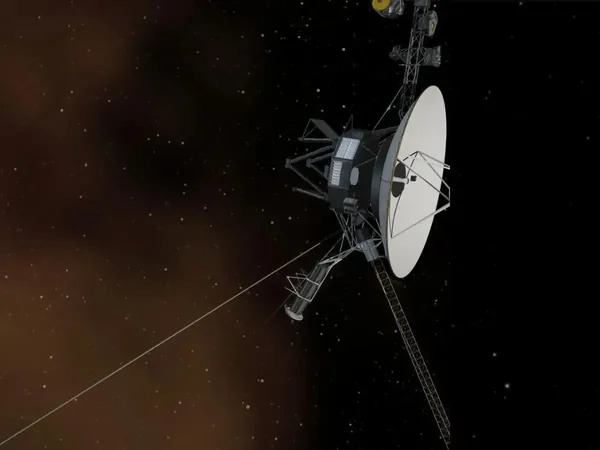
Astronomers Uncover the Brightest Fast Radio Burst Ever: What Lies Beyond?
2025-08-21
Author: William
A Groundbreaking Discovery in Astronomy
In an extraordinary breakthrough, a team of international astronomers, including experts from McGill University, has successfully pinpointed the origin of one of the brightest fast radio bursts (FRBs) ever detected. This finding not only astonished the research team but also sheds new light on one of the most enigmatic phenomena in astrophysics.
What Exactly Are Fast Radio Bursts?
Fast radio bursts are colossal flashes of radio waves that last mere milliseconds, originating from deep space. While scientists theorize that these bursts stem from extreme cosmic events, they have long struggled to trace their exact sources. Previous FRBs have baffled researchers, disappearing before they could be studied due to their fleeting nature.
The Remarkable FRB 20250316A
In March, the Canadian CHIME/FRB radio telescope detected a notably bright FRB, named FRB 20250316A, or affectionately known as "RBFLOAT" (Radio Brightest FLash Of All Time). This event marked a significant evolution in FRB research, enabling astronomers to identify its point of origin through the CHIME/FRB, which is now renowned for its FRB discovery prowess.
Amanda Cook, a lead researcher at McGill, stated, "This result marks a turning point: we can now see exactly where these mysterious flashes are coming from, opening doors to understand whether they are triggered by dying stars, rare magnetic phenomena, or something entirely unprecedented."
Mapping the Universe with Precision
To track the origin of RBFLOAT, researchers utilized CHIME’s newly established "outrigger" telescopes, spanning North America from British Columbia to California. This broad array provided unmatched spatial resolution, enabling them to trace the burst to a mere 45 light-years across—a region smaller than an average star cluster—on the outskirts of a galaxy approximately 130 million light-years away.
Cook elaborated, "The precision of this localization, tens of milliarcseconds, is akin to spotting a quarter from 100 kilometers away." This remarkable accuracy allowed them to identify the host galaxy, NGC 4141, matching the burst with a faint infrared signal captured by the advanced James Webb Space Telescope.
A Mysterious Infrared Signal
Their findings unveiled a puzzling source of near-infrared light precisely at the location of RBFLOAT. Researchers are left contemplating whether this anomaly signifies a red giant star or a fading light echo from the burst itself.
Peter Blanchard, a researcher from Harvard, noted, "The high resolution of JWST lets us discover individual stars surrounding an FRB for the first time. This breakthrough allows us to investigate the kind of stellar environments that could potentially give rise to such powerful bursts."
Unprecedented Observations: What’s Next?
Despite being the brightest FRB detected by CHIME, the source has not shown signs of repeating bursts, contrary to the typical behavior of known FRBs. This has prompted researchers to reassess existing models, suggesting that RBFLOAT may be energetically different from other repeaters they have studied.
"We’re now reevaluating some of the explosive models that had lost favor," stated Mawson Sammons, another McGill postdoctoral researcher. This reevaluation signifies a potential shift in understanding explosive cosmic events.
A New Era in Cosmic Discovery
The observations present in two studies provide groundbreaking methods for examining FRBs, not merely as cosmic enigmas but as valuable tools for exploring the universe. As Sammons puts it, "This marks the beginning of a new era where we can routinely localize even single, non-repeating bursts to pinpoint precision. That’s a game-changer for uncovering their underlying mechanisms."
Collaborative Research Efforts
The exciting discoveries associated with FRB 20250316A have been documented in studies authored by the CHIME/FRB Collaboration, comprising scientists from institutions like McGill, MIT, the University of Toronto, and many others. These significant results were published in *The Astrophysical Journal Letters*, marking a collaborative effort paved with support from notable organizations, including the Trottier Space Institute at McGill University.









 Brasil (PT)
Brasil (PT)
 Canada (EN)
Canada (EN)
 Chile (ES)
Chile (ES)
 Česko (CS)
Česko (CS)
 대한민국 (KO)
대한민국 (KO)
 España (ES)
España (ES)
 France (FR)
France (FR)
 Hong Kong (EN)
Hong Kong (EN)
 Italia (IT)
Italia (IT)
 日本 (JA)
日本 (JA)
 Magyarország (HU)
Magyarország (HU)
 Norge (NO)
Norge (NO)
 Polska (PL)
Polska (PL)
 Schweiz (DE)
Schweiz (DE)
 Singapore (EN)
Singapore (EN)
 Sverige (SV)
Sverige (SV)
 Suomi (FI)
Suomi (FI)
 Türkiye (TR)
Türkiye (TR)
 الإمارات العربية المتحدة (AR)
الإمارات العربية المتحدة (AR)